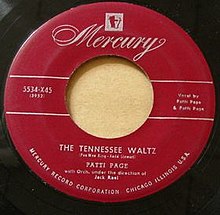Tennessee Waltz
Tennessee Waltz is a country song by Pee Wee King and Redd Stewart that first appeared in the version of Cowboy Copas in 1948 . In the pop version of Patti Page from 1950 the piece became a multi- million seller .
History of origin
Tennessee Waltz was composed in December 1946 by Pee Wee King and singer Redd Stewart, who was a member of King's companion group Golden West Cowboys, on the way back from a performance. When the Kentucky Waltz was announced on the car radio by bluegrass musician Bill Monroe , both of them were inspired to compose the new Tennessee Waltz .
In April 1947 the song was recorded with Cowboy Copas at King Recording Studios in Cincinnati and published on March 28, 1948 by King Records as catalog # 696 (B-side How Much Do I Owe You? ). It hit the country charts in May 1948 , where it reached third place. The song was produced by label owner Syd Nathan . Also Pee Wee King's version, recorded on December 2, 1947 at RCA Studios in Chicago with the Golden West Cowboys , reached third place in the country charts after its release on January 25, 1948 with 500,000 records sold.
Million seller as a pop song
When the jazz trumpeter Erskine Hawkins published his instrumental version of the Tennessee Waltz in October 1950 , Jack Rael, the manager and orchestra leader of the pop singer Patti Page , became aware of it. The pop version in the version by Patti Page was recorded on October 14, 1950 in five takes with the first voice overdubbing and adhered strictly to the arrangement by Erskine Hawkins. Released in November 1950 (Mercury # 5534), originally as the B-side of Long Long Ago , the record became their most successful hit, having been made three million times within eight months and subsequently a total of six million times. It reached number one on the pop hit parade on December 30, 1950, where it stayed for 13 weeks. The pop song, which was awarded a platinum record, also reached second place on the C&W charts as an "inverted crossover ". The US state of Tennessee adapted it as a State Song on February 17, 1965 .
Lyrically, it is a self-referential song, because a couple is dancing on the Tennessee Waltz when (in the page version) a friend of the singer appears who is teasing her boyfriend. Musically it has AABA structures, each 32 bars long.
Cover versions
According to BMI , the song has been covered 59 times, Coverinfo lists a total of 100 versions, while James M. Manheim even quotes 300 versions.
Almost every performer has the classic in their repertoire, including in 1950 Guy Lombardo and his Royal Canadians (December 1950), Les Paul / Mary Ford (December 1950), Jo Stafford (December 1950). Sam Cooke (May 1964; B-side of the single Good Times ) or Otis Redding (October 1966; LP Dictionary Of Soul ) have released soul versions in 4/4 time.
A version translated almost literally into German comes from the British pop singer Alma Cogan , who reached 10th place on the German charts with her first German single Tennessee Waltz / Mein schönster Traum (EMI # C-22.735) , released on October 30, 1964 . The song contained the identical rock music track (4/4) by the Charles Blackwell orchestra, which had previously been used in March 1964 for the English version of the single The Tennessee Waltz / I Love You Too Much . The pop singer Bärbel Wachholz had great success in the GDR in 1965 with her German-language cover version.
The song has also developed into a jazz standard : musicians such as Sonny Rollins , Bennie Wallace , Kirk Whalum or Norah Jones interpreted the ballad after Erskine Hawkins . The Tennessee Waltz received a BMI award. A total of ten million copies of the title were sold; Patti Page is even assuming 20 million.
Web links
- Peter Wicke: Tennessee Waltz . In: Song Lexicon . Retrieved October 9, 2014.
Individual evidence
- ↑ Bill Monroe recorded the song on February 13, 1945, but did not release it until January 14, 1946; according to Neil V. Rosenberg / Charles K. Wolfe, The Music of Bill Monroe , 2007, p. 49 ff. Neil V. Rosenberg / Charles K. Wolfe, The Music of Bill Monroe , 2007, can be found virtually as a Google book search
- ^ Wade H. Hall, Hell-Bent for Music: The Life of Pee Wee King , 1996, pp. 147 ff.
- ^ RIAA List of Millionsellers
- ^ Linnell Gentry, A History And Encyclopedia Of Country, Western, And Gospel Music , 1969, p. 84
- ^ Wade H. Hall, Hell-Bent for Music: The Life of Pee Wee King , 1996, p. 150
- ↑ James M. Manheim, B-side Sentimentalizer: "Tennessee Waltz" in the History of Popular Music , Musical Quarterly, 1992 volume 76, pages 337-354
- ↑ BMI entry for Tennessee Waltz ( page no longer available , search in web archives ) Info: The link was automatically marked as defective. Please check the link according to the instructions and then remove this notice.
- ↑ James M. Manheim, B-side Sentimentalizer: "Tennessee Waltz" in the History of Popular Music , Musical Quarterly, 1992 volume 76, page 337
- ^ Joseph Murrells, Million Selling Records , 1985, p. 50
- ^ Patti Page website

